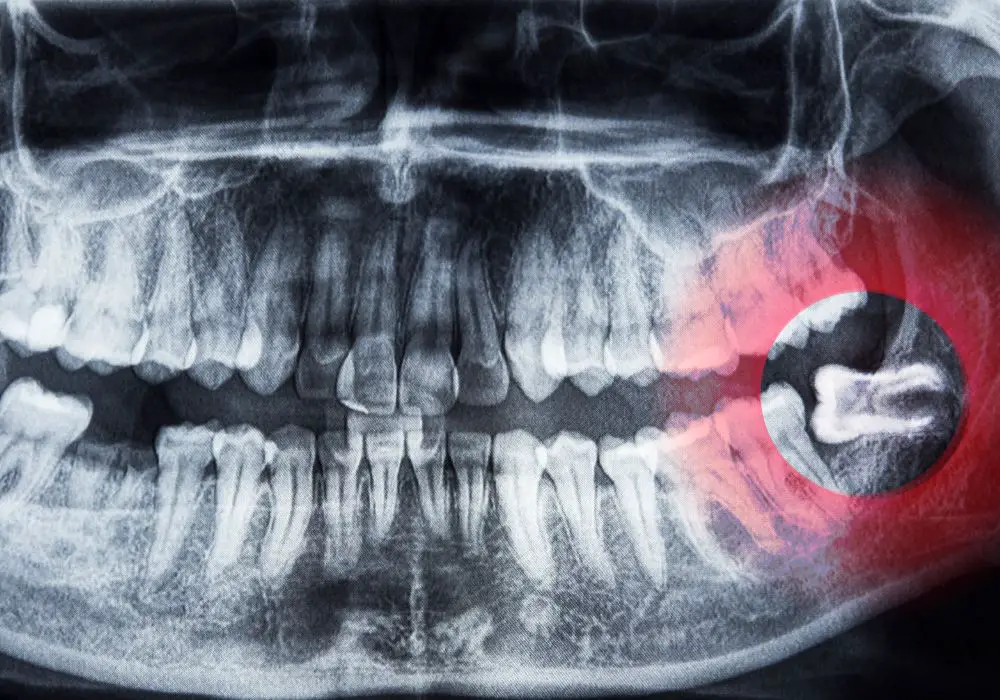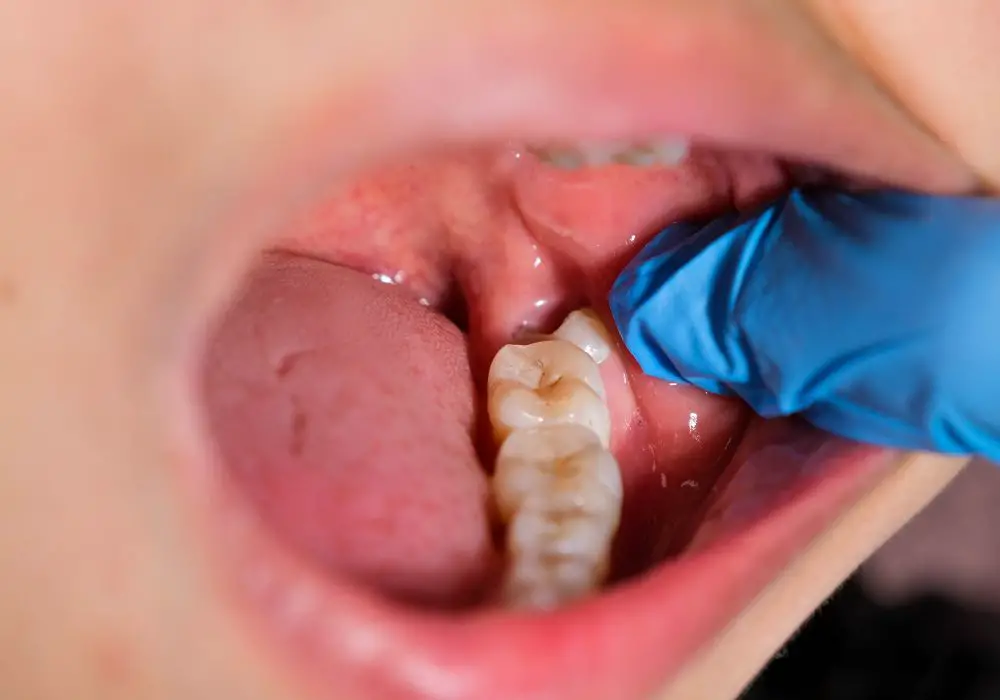Wisdom teeth, also known as third molars, are the last set of permanent teeth to erupt in the mouth. They typically grow in during the late teens to early 20s. While most people have four wisdom teeth (one in each corner of the mouth), it is not uncommon for them to only partially erupt or remain impacted below the gums. One interesting phenomenon that sometimes occurs with wisdom teeth is their tendency to predominantly grow in on just one side of the jaw. So what causes this unilateral growth pattern?
Key Reasons For Unilateral Wisdom Tooth Growth

There are a few key reasons why wisdom teeth may preferentially grow in on just one side:
Insufficient Space
One of the most common causes is simply insufficient space in the jaw. The upper and lower jaws continue to grow during the teenage years, but sometimes the final adult jaw size is too small to accommodate the wisdom teeth. Since the rear corners of the jaw are particularly tight, space limitations often prevent wisdom teeth from fully erupting. If space is limited on one side more than the other, this can lead to unilateral impaction where the wisdom teeth only partially emerge on the more crowded side.
Delayed Development
Wisdom teeth begin developing below the gums from ages 9-12, but don’t start erupting until the late teens. If wisdom teeth on one side develop later or slower than the other side, this staggered development can cause unilateral impaction. The teeth on the “slow side” have less time to reach the occlusal plane and fully erupt before the jaw bones harden.
Physical Obstructions
Physical barriers in the path of eruption can also hinder wisdom teeth from emerging on one side. The crown of an adjacent second molar or excessive bone density in the jaw can physically block wisdom teeth from erupting into place. This is more likely to occur unilaterally if the obstruction is on one side only.
Genetic Factors
Research suggests genetics may play a role in wisdom tooth impaction. People with smaller jaws and tooth size/structure influenced by heredity are more prone to crowding and obstruction of wisdom tooth growth. If genetic traits asymmetrically affect jaw size or third molar development between sides, this could inhibit eruption unilaterally.
Why The Mandibular Left Side Is Most Affected

While wisdom teeth can remain buried on either side, studies show the left lower wisdom tooth (mandibular third molar) is the most frequently impacted. Approximately 9 out of 10 cases of unilateral impaction involve the left mandibular wisdom tooth. But why is this side more affected than the others? A few anatomical factors contribute to this tendency:
Earlier Tooth Bud Formation
During early jaw development in childhood, wisdom tooth buds begin mineralizing sooner on the right side. The earlier formation on the right gives these teeth more time to develop before the jaw bones harden and provides a head start in the eruption process.
Later Mandibular Growth
While the wisdom teeth form earlier on the right, the body of the mandible typically grows and expands more later on the left. This later left-sided growth helps create more eruption space for the right teeth. The left teeth are at a disadvantage with less space.
Roots Curve Posteriorly
The roots of the mandibular left wisdom tooth also tend to curve backwards away from the direction of eruption. This orientation makes it harder for the left third molar to fully emerge upright.
Implications of Impaction

Failure of wisdom teeth to fully erupt into place can cause a number of complications:
- Crowding or displacement of other teeth
- Increased risk of cavities or gum disease
- Cysts or tissue damage from trapped partially erupted teeth
- Jaw pain, stiffness, or inflammation (pericoronitis)
- Tooth decay in impacted or adjacent teeth
- Orthodontic issues if extractions are later required
For these reasons, it is often recommended to have impacted wisdom teeth extracted even if no symptoms are currently present. However, not all wisdom teeth require removal. Monitoring by a dentist is advised to assess if surgical extraction is necessary.
Surgical Removal of Impacted Wisdom Teeth
If wisdom teeth are unable to fully erupt through the gums, a coronectomy or surgical extraction is usually required to remove them. Some key factors regarding surgical removal include:
- Timing – Removal is typically recommended between ages 17-25 before the jaw bones become too rigid. Removal later in life poses a higher risk of complications.
- Anesthesia – General anesthesia causes loss of consciousness while local anesthesia only numbs the area. Both can be used depending on the status of impaction and number of teeth being extracted.
- Incisions – A small incision is made in the gums overlying the impacted tooth. Some tissue may be removed if the tooth is partially visible.
- Tooth Sectioning – The tooth may be divided into pieces if the roots are curved or wrapped around nerves or other teeth.
- Recovery – Swelling, bruising, pain, and restricted jaw movement are common afterward. Healing takes 1-2 weeks.
Proper postoperative care helps minimize pain, infection risk, and other complications following wisdom tooth removal surgery.
Conclusion
In summary, wisdom teeth preferentially remain buried on one side of the jaw due to issues like space overcrowding, delayed development, physical obstructions, or genetic factors affecting tooth size and jaw growth. The mandibular left third molar is the most frequently impacted, primarily related to earlier mineralization on the right side and later growth on the left side of the mandible. Impacted wisdom teeth can lead to problems like tooth misalignment, decay, cysts, and pain. Therefore, surgical removal under anesthesia is often advised when eruption is obstructed. With proper timing and postoperative care, the risks of wisdom tooth extraction surgery can be minimized.
Frequently Asked Questions
Why do my wisdom teeth hurt on one side?
Wisdom teeth pain on just one side usually indicates the teeth are impacted on that side. Common causes of unilateral pain include pericoronitis (gum inflammation) around a partially erupted tooth, infection of the gum tissue or tooth pulp, pressure on other teeth, or cystic lesions associated with the buried wisdom tooth.
Can wisdom teeth only partially erupt?
Yes, it is very common for wisdom teeth to only partially emerge through the gums rather than fully erupting into place. They may only breach the soft tissue lining of the mouth but remain covered by gum tissue or bone. Partial eruption increases impaction risks.
What if I don’t have enough room for my wisdom teeth?
If your jaws are too small to accommodate your wisdom teeth, they will likely become impacted due to overcrowding. Limited space is one of the most common reasons wisdom teeth fail to fully erupt. In these cases, extracted is usually recommended to prevent later problems.
Can a wisdom tooth push other teeth?
Partially erupted wisdom teeth can sometimes push against adjacent teeth, causing pain, bite changes, or orthodontic movement of other teeth. This is one reason impacted wisdom teeth may require extraction even when no symptoms are present.
How do they remove impacted wisdom teeth?
Surgical removal (extraction) is done under local or general anesthesia via an incision in the gum tissue over the buried tooth. The tooth may be sectioned if the roots are curved or wrapped around other teeth. Stitches are placed after extraction and recovery takes about 1-2 weeks.







